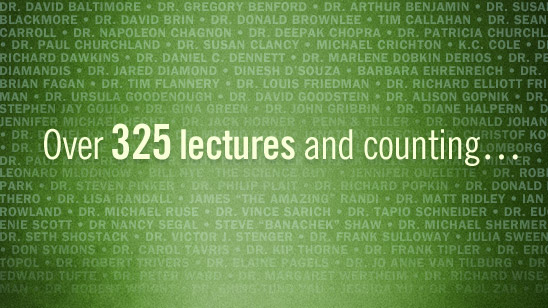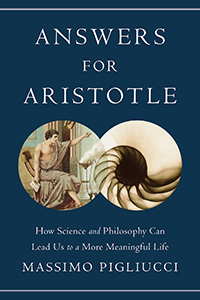In this week’s eSkeptic:
Our Next Lecture at Caltech:
DR. MARC RAYMAN

To Boldly Go…Well, You Know: NASA’s Dawn Mission to the Asteroid Belt
with Dr. Marc Rayman
Sunday, March 17, 2013 at 2 pm
THE AMBITIOUS DAWN MISSION, launched in September 2007, is one of NASA’s most remarkable ventures into the solar system. The spacecraft has recently completed a spectacular exploration of Vesta and is now traveling to Ceres; these were among the last uncharted worlds in the inner solar system prior to Dawn. They are the two most massive residents of the main asteroid belt. Ceres is so large that it is included in the category of dwarf planets, along with Pluto. Remnants from the time that planets were formed, Ceres and Vesta hold clues that will help scientists understand the dawn of the solar system. Dawn orbited Vesta from July 2011 to September 2012 and returned astonishing views of this fascinating world. It is the only spacecraft ever to orbit an object in the asteroid belt. Such a mission would be impossible without the use of ion propulsion, a technology that has mostly been in the domain of science fiction, but which was tested extensively on the Deep Space 1 mission, paving the way for Dawn. Dr. Marc Rayman, Dawn’s Chief Engineer and Mission Director at JPL, will describe the Dawn mission and its use of ion propulsion as well as its two exotic destinations. He will also share the excitement and profundity of controlling a spacecraft in deep space.
Followed by…
- Give and Take: A Revolutionary Approach to Success
with Dr. Adam Grant
Sunday, April 28, 2013 at 2 pm - Odd Couples: Extraordinary Differences between the Sexes
in the Animal Kingdom
with Dr. Daphne J. Fairbairn
Sunday, May 19, 2013 at 2 pm
New Admission Policy and Prices
Please note there are important policy and pricing changes for this season of lectures at Caltech. Please review these changes now.
Recent Lectures Newly Available on DVD
-
 Consciousness: Confessions of a Romantic Reductionist
Consciousness: Confessions of a Romantic Reductionist
by Dr. Christof Koch
-
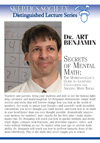 Secrets of Mental Math: The Mathemagician’s Guide to Lightning Calculation and Amazing Math Tricks
Secrets of Mental Math: The Mathemagician’s Guide to Lightning Calculation and Amazing Math Tricks
by Art Benjamin -
The famous lightning calculator and mathemagician Art Benjamin demonstrates simple math secrets and tricks that will forever change how you look at the world of numbers. Learn how to amaze your friends and yourself with incredible calculations you never thought you could master, and learn how to do math in your head faster than you ever thought possible, dramatically improve your memory for numbers, and maybe for the first time make mathematics fun… ORDER THE LECTURE ON DVD.
-
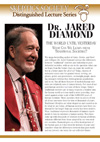 The World Until Yesterday: What Can We Learn from Traditional Societies?
The World Until Yesterday: What Can We Learn from Traditional Societies?
by Dr. Jared Diamond

NEW ON SKEPTICBLOG.ORG
Towards a Science of Morality: A Reply to Massimo Pigliucci
In this year’s annual Edge.org question “What should we be worried about?” I answered that we should be worried about “ The Is-Ought Fallacy of Science and Morality.” I wrote: “We should be worried that scientists have given up the search for determining right and wrong and which values lead to human flourishing”. Evolutionary biologist and philosopher of science Massimo Pigliucci penned a thoughtful response, which I appreciate given his dual training in science and philosophy, including and especially evolutionary theory, a perspective that I share. But he felt that my scientific approach added nothing new to the philosophy of morality, so let me see if I can restate my argument for a scientific foundation of moral principles with new definitions and examples.
First, morality is derived from the Latin moralitas, or “manner, character, and proper behavior.” Morality has to do with how you act toward others. So I begin with a Principle of Moral Good:
Always act with someone else’s moral good in mind, and never act in a way that it leads to someone else’s moral loss (through force or fraud).

Should You Answer Aristotle?
SKEPTICALITY EPISODE 201
This week on Skepticality, Derek interviews Massimo Pigliucci about his latest book, Answers for Aristotle: How Science and Philosophy Can Lead Us to A More Meaningful Life, discussing what led him to write the book, and getting his personal take on the modern skeptical movement.
Get the Skepticality App
Get the Skepticality App — the Official Podcast App of Skeptic Magazine and the Skeptics Society, so you can enjoy your science fix and engaging interviews on the go! Available for Android, iPhone, iPad, and iPod Touch. Skepticality was the 2007 Parsec Award winner for Best “Speculative Fiction News” Podcast.
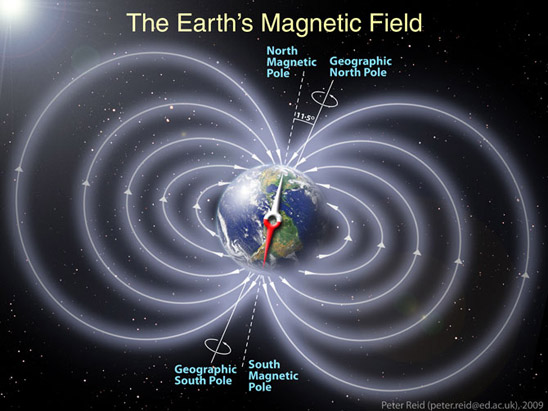
Schematic illustration of Earth’s magnetic field. Credit: Copyright 2009 Peter Reid,
The University of Edinburgh
About this week’s eSkeptic
Should we worry about pole shifts and changes in the Earth’s magnetic field causing a global apocalypse? In this week’s eSkeptic, Donald R. Prothero discusses some of the common misconceptions about magnetism and Earth’s magnetic field. Read Prothero’s full bio.
Magnetic Myths
Why magnets and magnetic fields attract
New Age flimflam and flapdoodle
by Donald R. Prothero
Throughout the long buildup up to the latest failed prediction of a global apocalypse on December 21, 2012, you would hear people claiming that the earth-shattering catastrophe would include “pole shifts,” or “changes in the earth’s magnetic field,” and assorted other sciencey phrases, proclaimed by people with absolutely no idea what they were talking about.
The idea of “magnetism” is one of the most popular memes in the lexicon of pseudoscientists and New Agers, since magnets operate “mysteriously” and exert a force at a distance. From the days of Franz Mesmer claiming he had “magnetism” over people, to the trite phrase “animal magnetism,” the concept of magnetism has always been mysterious and misunderstood. Hence the big market for sticking magnets on various parts of your body to “cure” you. All they do is waste money, and possibly demagnetize the magnetic strip on your credit cards. The idea that somehow the earth’s magnetic field will shift abruptly or that the earth’s core will stop rotating (as in the idiotic Hilary Swank movie “The Core”) or even more wildly, that the earth’s rotational pole will change, are all common ideas out there in Wacko-Land.
Most of us know enough about science and apocalyptic predictions to guess that they are not worth taking seriously, but very few people have bothered to debunk this stuff. Unfortunately, we saw lots of sad consequences of people who did take the ridiculous apocalyptic predictions seriously, often with tragic results. Among my other specialties, my professional training is in paleomagnetism, and I’ve conducted over 35 years of published research in the field, so I’m very familiar with what we do and do not know about the earth’s magnetic field and how it behaves.
First, some science
The earth’s magnetic field has at least two components, the dipolar field, which makes up about 90% of the magnetism we normally feel, and a non-dipole field, which is normally hard to detect beneath it but makes up at least 10% of the earth’s field. The dipole field is not exactly lined up with the rotational axis of the earth (i.e., there is a small angle between magnetic north and true north), but over geologic spans of time, this magnetic north wanders around the rotational pole; this movement is known as secular variation. Studies have shown that over the long term, its position averages out to being identical to the rotational pole. The field is generated by complex fluid dynamos operating within the outer core of the earth (made of iron and nickel), which operates a bit like a spinning dynamo made of copper wire (a good conductor), which generates a magnetic field and electrical current when it spins within a magnetic field. The exact nature of how this works is a matter of the complexities of geophysical fluid dynamics, so scientists are still working on modeling what kinds of dynamos are found in the outer core. But whatever their configuration, the model has to fit the constraints that the direction can be reversed (so a compass pointing north now would point south 800,000 years ago), and also explain the odd behavior of the field when the dipole component weakens and the non-dipole component becomes visible.
Now let’s consider some of the common false claims about magnets and magnetism that plague the Internet:
1. Earth’s field is about to reverse! The earth’s field does reverse direction, but normally the process takes 7000–10,000 years to complete. It does not happen in days or weeks, as some claim. We know this from detailed studies of thick stacks of lava flows that erupted over the span of a reversal, as well as high-resolution deep-sea cores that span the interval as well. So if the field were beginning to reverse, we would not know for at least a few thousand years. And we cannot predict when this reversal will occur, since they have been occurring on an irregular basis for all of geologic history, and at least a 300 times in the past 100 million years. Reversals typically occur roughly every 200,000–300,000 years apart, although the last reversal (the Brunhes-Matuyama boundary) was over 780,000 years ago. Some, however, are much shorter (less than 50,000 years), while in some cases the earth’s field remained stable for 30 million years. This irregular pattern of field reversals is completely unpredictable, but it also gives a nice non-periodic, non-repeating signal, like a bar code, that allows magnetic stratigraphers to correlate their local magnetic sequences with the global pattern.
2. When the field reverses and vanishes, we’ll all be bombarded by cosmic radiation! When the field slowly reverses over thousands of years, only the dipolar component of the field weakens. The non-dipole component of the field is always present, and there’s no evidence that the earth has ever been unshielded from cosmic radiation or completely lacked magnetic field. Nor is there any evidence that a slightly weaker magnetic field over the thousands of years when the dipole field is reversing will have any affect on life, or on our electrical grid, or anything else. Calculations show that during reversal, the field is only slightly weaker than we feel normally—about the difference between the field we would feel at the equator and the field we would feel at the magnetic north pole. In other words, it is undetectable except by sensitive instruments. In fact, a former professor of mine (Jim Hays of Lamont-Doherty Earth Observatory, a micropaleontologist and my co-author on several papers) conducted the crucial experiment on the issue over 40 years ago. He was the first to see the evidence of field reversal in deep-sea cores from the Antarctic, and wondered if there was any effect on life. Jim Hays’ first effort in 1971 (Hays, J.D. 1971. Faunal extinctions and reversal of the Earth’s magnetic field. Geological Society of America Bulletin, 82, 2433–2447) demonstrated no association between field reversals and extinctions, and it has since been corroborated over and over again by a wide variety of statistical techniques. And why should there be any extinction? If the difference in the field felt by organisms is so slight, and the effect on the cosmic ray influx is so tiny, there’s no reason to expect otherwise. At very worst, a weaker magnetic field with a relatively strong non-dipole component might disorient animals (from bees to whales to birds) that navigate by the field direction, but there’s no way to test that hypothesis in the fossil record, and no evidence that it’s happening to organisms right now.
3. What about recent studies that showed much more rapid field changes? These were conducted by my former colleague Scott Bogue at Occidental College. Bogue was looking at a set of lava flows that cooled as the field was reversing and weakening, and he focused on just the field recorded when the dipole field was nearly gone, and the non-dipole field was revealed. The non-dipole field does indeed move rapidly and in weird ways, but there’s no evidence that anything has been affected by such weird field directions during the short period of time that it is the dominant field of the earth. And there’s no evidence that the much stronger dipolar field will ever change that fast.
4. What about the evidence that the magnetic pole is rapidly changing direction? This is a long-studied and well-known phenomenon called secular variation, as I have already mentioned. It is not news, nor is it some scandalously dangerous discovery being hidden by NASA. It is a constant feature of the earth’s magnetic field, but over time the average direction of the magnetic pole averages out to be approximately the same as the rotational pole. We can study secular variation over thousands of years as recorded in deep-sea cores, lake sediment cores, and many other records. There is no scary change that threatens us, just a lot of noisy wobbling of the magnetic north that averages out to nothing in the long run.
So the next time you hear someone worrying about the earth’s magnetic field, you can assume that it is misinformed and false. There are plenty of real dangers to worry about, like global climate change, so we don’t need to scare people by hyping false ideas. ![]()
About the Author

DR. DONALD R. PROTHERO was Professor of Geology at Occidental College in Los Angeles, and Lecturer in Geobiology at the California Institute of Technology in Pasadena. He earned M.A., M.Phil., and Ph.D. degrees in geological sciences from Columbia University in 1982, and a B.A. in geology and biology (highest honors, Phi Beta Kappa) from the University of California, Riverside. He is currently the author, co-author, editor, or co-editor of 32 books and over 250 scientific papers, including five leading geology textbooks and five trade books as well as edited symposium volumes and other technical works. He is on the editorial board of Skeptic magazine, and in the past has served as an associate or technical editor for Geology, Paleobiology and Journal of Paleontology. He is a Fellow of the Geological Society of America, the Paleontological Society, and the Linnaean Society of London, and has also received fellowships from the Guggenheim Foundation and the National Science Foundation. He has served as the President and Vice President of the Pacific Section of SEPM (Society of Sedimentary Geology), and five years as the Program Chair for the Society of Vertebrate Paleontology. In 1991, he received the Schuchert Award of the Paleontological Society for the outstanding paleontologist under the age of 40. He has also been featured on several television documentaries, including episodes of Paleoworld (BBC), Prehistoric Monsters Revealed (History Channel), Entelodon and Hyaenodon (National Geographic Channel) and Walking with Prehistoric Beasts (BBC). His website is: www.donaldprothero.com. Check out Donald Prothero’s page at Shop Skeptic.


